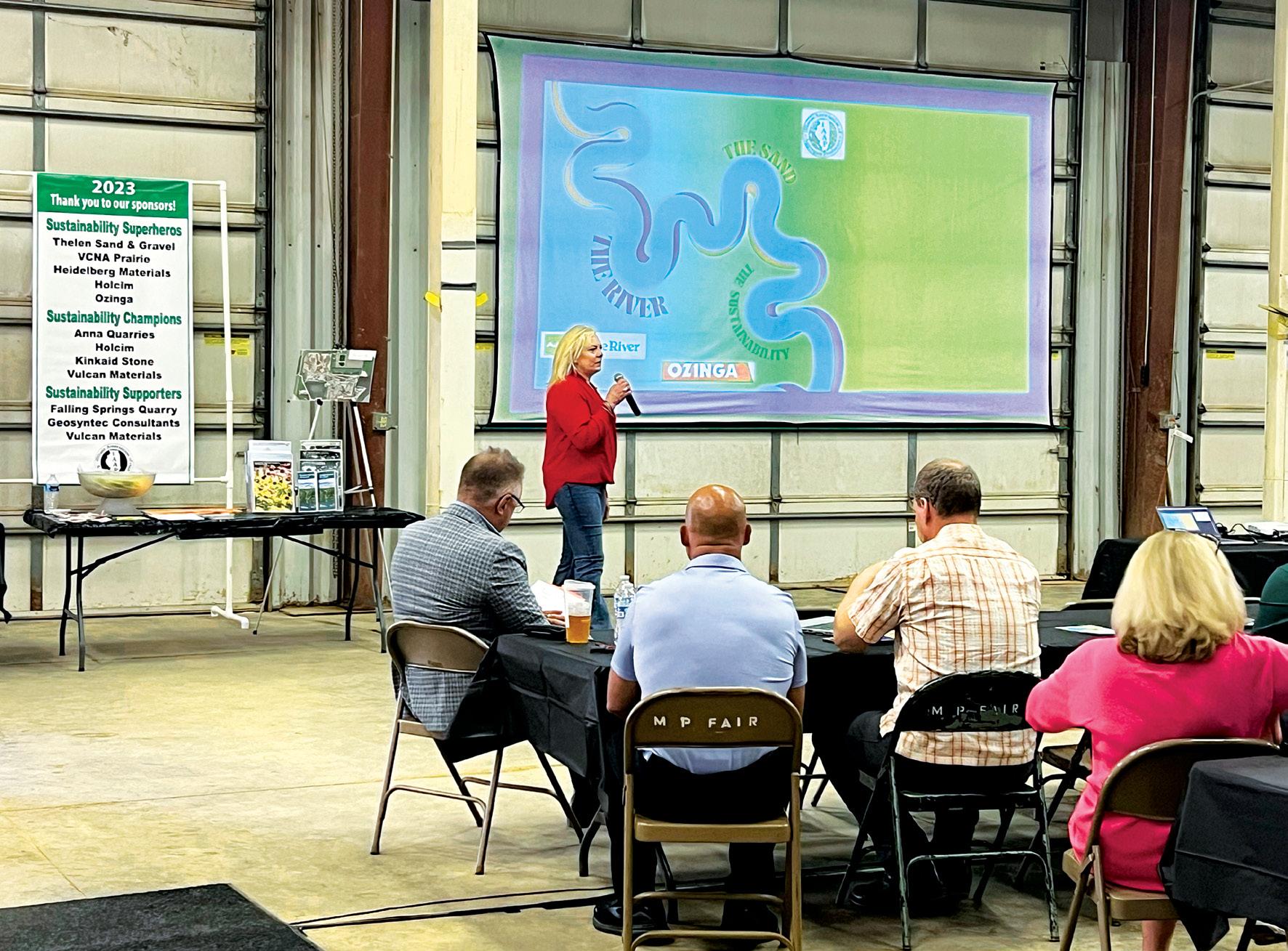
5 minute read
IAAP Sustainability Committee event at Ozinga Materials Inc.
Understanding the importance of sustainability
IAAP Sustainability Committee event at Ozinga Materials Inc.’s Henry location highlights practices geared toward achieving carbon neutrality
For nearly 100 years, Ozinga has been providing concrete and aggregate products and solutions to customers throughout the Midwest from dozens of locations across Wisconsin, Indiana and Illinois. Recognizing that in order to maintain that legacy, the fifth-generation business is committed to using sustainable practices and is helping others do the same.
Ozinga Materials Inc., a branch of Ozinga, recently teamed up with the Illinois Association of Aggregate Producers (IAAP) Sustainability Committee to host an event at Ozinga Materials’ Henry, Ill., location, so those in attendance could better understand the importance of sustainability in the industry. Ozinga Materials has been a leader in sustainability practices and has won multiple Certificates of Achievement in Environmental Excellence from IAAP. Ozinga is working toward being carbon neutral by 2030.
“Sustainability means we meet the needs of today while leaving something for future generations,” stated Carolynn Kloese, Operations Analyst for Ozinga Materials and Chairperson on the IAAP Sustainability Committee. “When it comes to sustainability, it’s really important that all hands are on deck. That’s what we wanted to convey, as well as to show some of the practices Ozinga has implemented in our goals to lower our carbon footprint.”

Kloese continued, “Today’s event was about the river, the sand and the sustainability. The focus was how we can marry what we do in our day-to-day work and our roles on the planet and become more sustainable, and what tools we can put in people’s hands to learn more about being sustainable.”
Barging ahead
Located on the Illinois River about two hours southwest of Chicago, Ozinga Materials’ Henry location is a model for those looking for ways to implement sustainability practices. It houses a pit for mining sand and aggregates and is home to Middle River Marine, a sister company that barges materials up and down the river, including to Ozinga Materials' ready-mix plants in Chicago.
“Our purpose at Henry is to mine and create a water port for commerce via barge, rail and truck,” said Jeff Radack, Vice President and General Manager of Ozinga Materials. “Barging is big for us because it’s a much more efficient and sustainable way to move materials. It reduces congestion in the city because there is less truck traffic. We’re moving six to 12 barges out per week. We invited industry folks — equipment suppliers, partners and other aggregate suppliers — to see our practices and hopefully learn something new about sustainability.”
Middle River Marine President Aaron Halcomb said the company and Ozinga Materials are learning from others in the aggregate industry as well. Middle River Marine is also working with legislation to make sure that it is a sustainable part of the supply chain.
“In our experience, we are 30% more efficient using barging versus railcar and over 1,000% more efficient compared to trucking,” said Halcomb. “Now, we still need railcar and trucks to move materials to their inland destinations, but we are cutting down those means considerably. We like our space, and we feel very good about what we do for the environment.”

Learning for all
Roland Machinery Company is an associate member of IAAP and was among those invited to attend the event. Ozinga Materials has purchased equipment from Roland Machinery with the help of Territory Manager Jeff Mikus, such as a Komatsu WA500-8 wheel loader that it uses to load trucks, material bins and its barges, as well as a Kleemann MR 130 mobile impact crusher. Mikus also helped Ozinga Materials with a demo of a Komatsu HB365LC-3 hybrid excavator.
“This is a great opportunity to get a firsthand look at what Ozinga is looking forward to with the future and how we can help them in their efforts to be more sustainable,” said Mikus. “I saw it as a way for us and our partners like Komatsu to think about ways to better engineer equipment to meet customers’ needs and be more sustainable moving forward.”
Komatsu Senior District Sales Manager Jenkins Davis gave a presentation on Komatsu’s commitment to be carbon neutral by 2050, which includes designing new products and solutions such as Smart Construction and Smart Quarry that help increase efficiencies and reduce emissions.
“It was interesting to see that the audience understands the challenges manufacturers face in achieving sustainability goals without sacrificing productivity,” said Davis. “Sustainability is something we are all striving for, and the things we learn from each other will add value as we proceed down this path together to accomplish our objectives. Events like this that show what customers like Ozinga are doing are very helpful, and I really appreciate being a part of it.”
Davis’ presentation was one of several during the event that hit on topics from manufacturing to best practices to the power of using native plants. Jess Koetzle, Assistant Director of IAAP, noted that more than 60 people attended the event, and IAAP is planning another one.
“We know that these materials are needed in order to build roads, bridges, homes and infrastructure,” said Koetzle. “We want to be able to use them while protecting the environment, being fiscally responsible and giving back to our communities. This is a way to educate those in and out of our industry about what companies like Ozinga are already doing and get ideas about how we can do more.”




